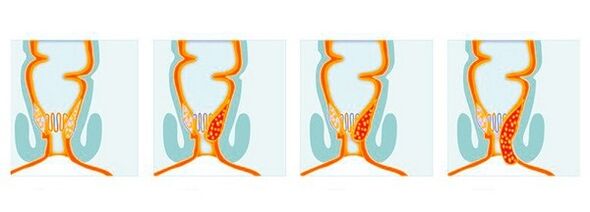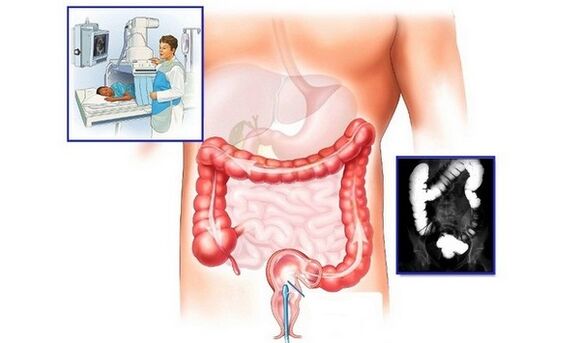
Hemorrhoids are a disease in which there is blood stasis and abnormal changes in the blood vessels of the rectum or in the area surrounding the anus. There is no age or gender restriction for such a sensitive pathology.
The main factor that leads to the formation of hemorrhoidal cones is stagnation, which is caused by many other predisposing factors.
It is characterized by characteristic symptoms that a pathological person cannot ignore. The most specific clinical signs of hemorrhoids are itching and burning in the anal area, rectal bleeding, and severe pain in the perianal area.
The clinician will be able to make a correct diagnosis based on a physical examination, but some additional laboratory and instrumental examinations may be needed.
Treatment of hemorrhoids depends directly on the severity of the disease, so it can be both conservative and surgical.
Because the pathology has very few types, it is coded in several senses in the International Classification of Diseases.
Etiology
The main reasons for the formation of hemorrhoidal cones:
- dysfunction of the vessels of this organ;
- increased arterial blood flow;
- impaired blood flow from the venous plexus;
- loss of tone of the rectal vessels, which causes them to dilate and the appearance of nodules.
In addition, clinicians identify a large number of unfavorable factors that cause the above processes, and therefore are generally divided into several groups - pathological and physiological.
The first category of causes of hemorrhoids includes:
- chronic constipation - hardened stool damages the walls of the rectum and anus;
- severe intoxication of the body - this should include alcohol, poisoning with toxic and chemical substances, as well as poor quality food;
- abundant diarrhea of an infectious nature;
- formation of malignant, less benign tumors in the intestine;
- diseases of the pelvic organs such as prostatitis or cystitis;
- inflammatory diseases of the digestive system;
- hormonal diseases;
- portal hypertension and cirrhosis of the liver, as well as other diseases of this organ. The connection of hemorrhoids to the liver is due to the presence of common veins;
- pathological effects of pathogenic bacteria that cause the development of infections.
In addition to diseases and disorders, the causes of hemorrhoids may not be completely related to the presence of one or another disease in the body. Among the physiological factors worth noting:
- lack of physical activity - this occurs against the background of various sources - laziness, a serious illness that deprives the patient of the ability to move, as well as special working conditions in which a person is forced to sit or stand during working hours;
- excess body weight;
- malnutrition - this includes the consumption of fatty, spicy foods, smoked meats, confectionery, carbonated beverages, semi-finished products, fast food and other harmful substances. For this reason, diet therapy is one of the components of hemorrhoid treatment;
- non-discriminatory use of drugs, including laxatives or oral contraceptives;
- improper performance of proctological diagnostic procedures or enemas;
- non-traditional sexual preferences, ie anal sex;
- long-term effects of stressful situations;
- carrying out heavy physical activity;
- engage in certain sports, especially cycling or motorcycles, equestrian sports and other weightlifting;
- excessive drinking and smoking;
- period of birth of a child or labor;
- menstruation.
Genetic predisposition plays an important role in the development of the disease. It is very likely that one of the closest relatives will be diagnosed with a similar pathology. Knowing this, you can independently prevent the appearance of a disease, you just need to follow all the rules to prevent hemorrhoids.
Classification
According to the clinical nature of the disease:
- acute - this is the first manifestation of previously undiagnosed hemorrhoids;
- chronic - characterized by an alternation of stages of exacerbation of symptoms and their withdrawal.
Depending on the formation of hemorrhoids, cavernous pathology is divided into:
- External hemorrhoids - if the tubercle appears under the skin of the anus, not under the mucous membrane of the rectum. It is considered the rarest form of the disease;
- internal hemorrhoids are the most common pathological type in which vascular cones form directly in the anal canal;
- Mixed hemorrhoids are the second most common type of disease, characterized by the presence of symptoms in the two forms described above.
In addition, there are types of hemorrhoids that are divided into severity:
- mild course - symptoms may be absent or insignificant. Conservative methods predominate in therapy;
- moderate - characterized by an increase in nodules and the addition of pain sensations caused by fecal injury. During defecation, internal sediments are shed, after which they straighten themselves. The disease can be eliminated with minimally invasive methods;
- Severe - is characterized by the expression of a hemorrhoid symptom such as bleeding. Knots can fall not only during bowel movements, but also in other situations that cause an increase in intra-abdominal pressure. In such cases, they can only be adjusted manually. How to get rid of hemorrhoids can involve both minimally invasive procedures and extensive surgery;
- Complicated - is characterized by an increase in symptoms of the disease, and the development of complications is often observed during diagnosis, one of which may be thrombosis. However, not all cases of hemorrhoids are treated in time, but the consequences do occur.

Symptoms
The first signs of hemorrhoids can be so small that a person does not pay attention to them. The initial clinical manifestations are as follows:
- a small discomfort in the anus;
- non-intense itching of the anal area;
- pain during bowel movements;
- swelling of the entrance to the anal canal.
As the disease progresses, the following hemorrhoid symptoms will begin to appear:
- burning and severe itching;
- increasing pain that will appear not only during bowel movements, but also during strenuous walking or prolonged sitting;
- appearance of blood and mucus impurities in the stool. It is noteworthy that pathological clots do not mix with feces, but rather settle;
- hemorrhoidal tube prolapse causing severe pain;
- redness of the skin of the perianal region;
- rectal bleeding - in the early stages, if such a symptom of hemorrhoids can manifest itself only in the form of blood stains on toilet paper or underwear, it can reach the intensity of bleeding in a complex course. This is what often forces a person to seek help.
In addition to specific clinical manifestations, the above hemorrhoid symptoms may be accompanied by an increase in body temperature, which indicates the development of the inflammatory process.
Diagnostics
It often happens that when a symptom appears, a person does not know which doctor to consult for hemorrhoids. A proctologist or surgeon is involved in the diagnosis and treatment of hemorrhoids, but you can contact a therapist for an initial consultation. It should be noted that if a child has symptoms, a pediatrician should be seen immediately, and if there is a pregnant woman, they should first consult a midwife-gynecologist.
The first stage of diagnosis involves the clinician's work aimed at:
- a detailed survey of the patient with the first signs of hemorrhoids - to determine the stage of the disease;
- acquaintance with the medical history and life history of not only the patient, but also relatives - it is enough to determine why the hemorrhoids appear;
- conducting an objective examination aimed at assessing the condition of the perianal region and digital examination of the rectum, which will allow to distinguish internal hemorrhoids from the outside and determine the localization of the tubercle.
The second step in making a correct diagnosis is laboratory tests, such as a general, biochemical blood test and a coagulogram.
The final part of the diagnosis is an instrumental examination of the patient, aimed at assessing what the hemorrhoids look like and providing the following.
- sigmoidoscopy;
- anoscopy;
- colonoscopy;
- radiography using a contrast agent;
- Ultrasound examination of the abdominal organs.

Only after examining the results of the examination, the clinician develops tactics on how to treat hemorrhoids in a patient.
Treatment
The treatment regimen will depend on the severity of the disease, but common methods of treating hemorrhoids include:
- use of drugs for both local and general effects. In the first case, rectal suppositories, ointments, creams and gels are used, in the second - tablets to improve blood circulation, strengthen blood vessels and neutralize the accompanying symptoms;
- Follow a frugal diet - indicated for both external and internal hemorrhoids. All recommendations regarding the menu and cooking methods are provided by the attending physician;
- minimally invasive techniques to remove hemorrhoids;
- open operation;
- use of alternative medicine prescriptions. This should include making candles and ointments from natural ingredients at home, as well as mixtures made from herbs and plants used for reception or as microclysters and sitz baths.
Among the minimally invasive methods of treatment of hemorrhoids should be noted:
- direct insertion of sclerosing substances into the node;
- fastening with latex rings;
- infrared and electrocoagulation;
- cryodestruction;
- pampering.
Hemorrhoid removal tactics will be determined by the pathological stage.
In addition to the ineffectiveness of conservative methods, open surgery is indicated in cases of complicated disease - hemorrhoidectomy.
How to treat hemorrhoids in pregnant women and children will be asked by a midwife-gynecologist and a pediatrician.
Possible complications
Ignoring the apparent clinical phenomena and late treatment of hemorrhoids often leads to the development of the following consequences:
- joining the secondary infection;
- spread of the inflammatory process;
- anal sphincter insufficiency;
- excessive bleeding causing anemia;
- proctitis and paraproctitis;
- formation of blood clots;
- anal fissures.
Prevention and prognosis
The following prevention rules should be followed to prevent the appearance of hemorrhoids:
- lead a healthy and moderately active lifestyle;
- eat properly and in a balanced way;
- strengthen the pelvic and abdominal muscles;
- take medication only as directed by your doctor;
- if possible, avoid physical and emotional stress;
- timely treatment of constipation and other pathological causes of hemorrhoids;
- make sure your body weight is normal;
- undergo regular full physical examination.
It is impossible to answer the question of the prognosis of hemorrhoids unequivocally, because the result depends on several factors - the stage and form of the disease, age category, time of onset of hemorrhoid treatment and the suitability of the patient. all recommendations of clinicians.
People with a diagnosis of hemorrhoids often ask if it can go away on its own? The answer of doctors will always be negative - the disease will become chronic.
























